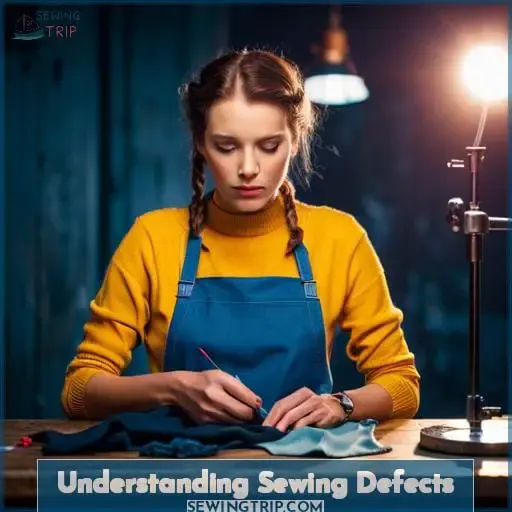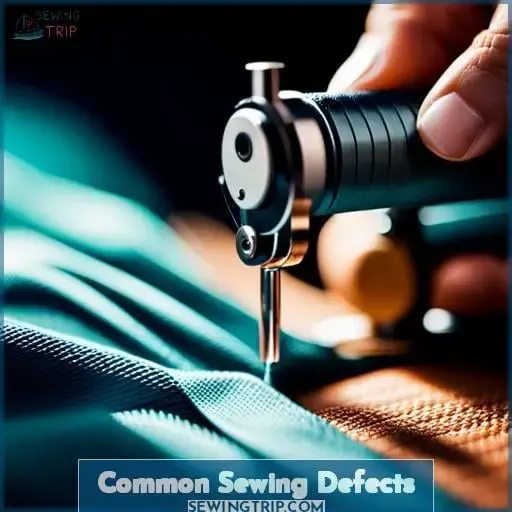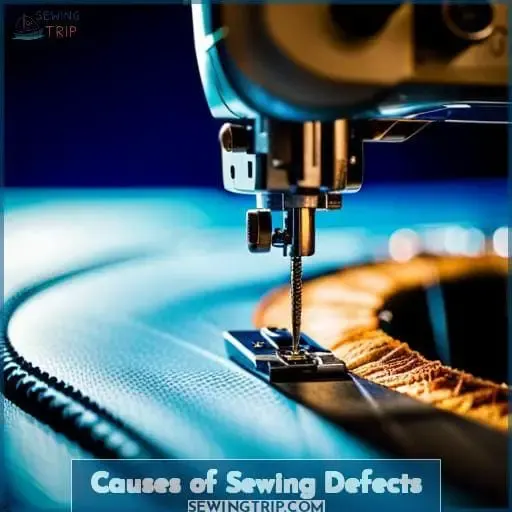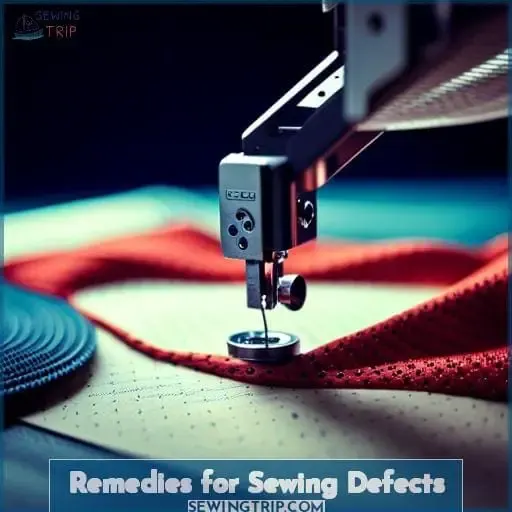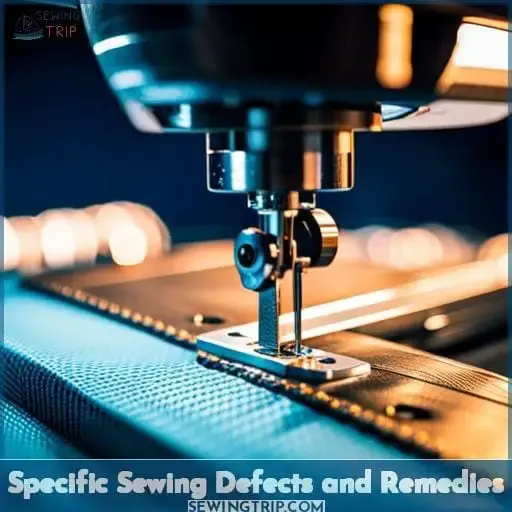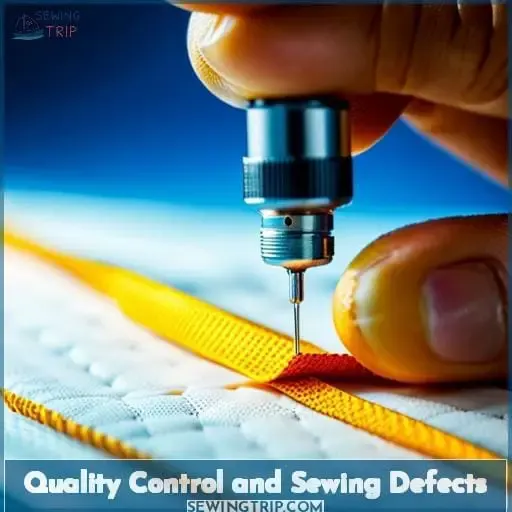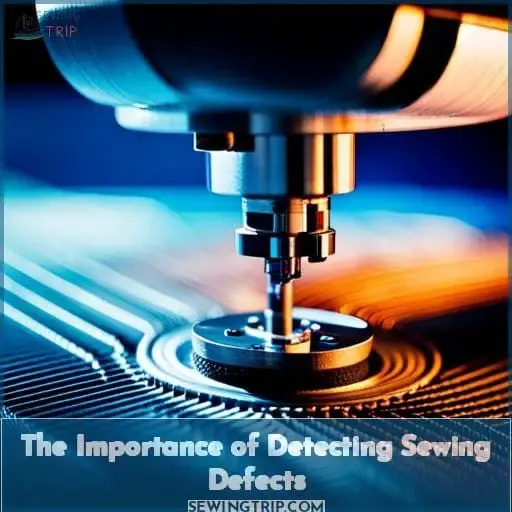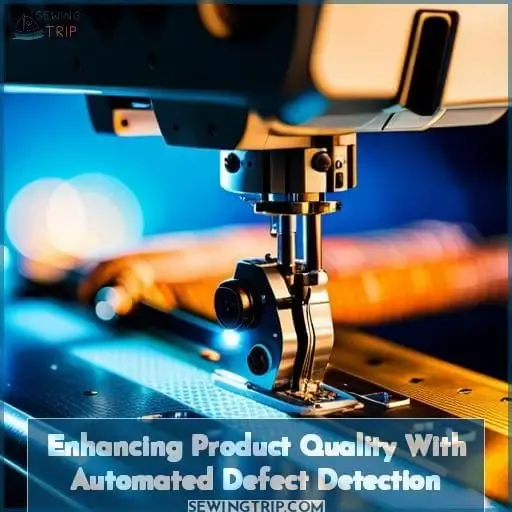This site is supported by our readers. We may earn a commission, at no cost to you, if you purchase through links.
Sewing defects can be a major source of frustration and lost time in the garment industry. It is important to understand what sewing defects are, as well as their causes, types, and remedies. Sewing mistakes not only lead to wasted materials but also result in decreased productivity and poor product quality.
Knowing how to identify common sewing faults is key for maintaining high standards of workmanship across your production line. Additionally, automated defect detection systems can help enhance product quality while minimizing losses from rework or repairs.
In this article, we will discuss the various aspects related to understanding sewing defects, including its different types, causes, and solutions.
Table Of Contents
- Key Takeaways
- Understanding Sewing Defects
- Types of Garment Defects
- Common Sewing Defects
- Causes of Sewing Defects
- Remedies for Sewing Defects
- Specific Sewing Defects and Remedies
- Quality Control and Sewing Defects
- The Importance of Detecting Sewing Defects
- Enhancing Product Quality With Automated Defect Detection
- Minimizing Sewing Defects With DMAIC Methodology
- Frequently Asked Questions (FAQs)
- Conclusion
Key Takeaways
- Sewing defects in the garment industry can cause frustration and lost time, and understanding their causes is crucial for maintaining high workmanship standards.
- Common sewing defects include broken stitches, unraveling seams, sagging pockets, and ropy hems. Thread tension and fabric quality are important factors in preventing these defects.
- Proactive defect prevention strategies, like proper machine maintenance and operator training, should be implemented throughout every stage of production. Improper fabric selection or handling, poor quality thread, inadequate sewing techniques, or insufficient quality assurance measures can cause sewing defects.
- Automated defect detection systems and DMAIC methodology can be utilized to reduce defects in the final product and ensure consistently high product quality and improved productivity. This leads to better customer satisfaction and cost savings.
Understanding Sewing Defects
Understanding sewing defects can help you better equip yourself to create garments of the highest quality and ensure customer satisfaction. Common issues, such as broken stitches, unraveling seams, sagging or rolling pockets, and ropy hems, are all preventable with proper machine maintenance and adjustments.
Thread tension must be set correctly. If it is too loose, it may cause puckers, while if it is too tight, it could lead to fabric distortion or hole formation due to the barrie effect. Fabric quality should also be taken into consideration when setting thread tensions to prevent it from becoming boardy over time from tucking on the underside of the material.
Color fastness is another important factor. Use threads that will resist fading during washing cycles with correct pH levels and water temperature settings for ideal results. Reinforcement tape may also provide additional support against seam slippage across stretch fabrics if differential feed techniques are employed accordingly in between topstitching operations along edges where skewing might occur otherwise.
Types of Garment Defects
Now that you have an understanding of sewing defects, let’s look at the types of garment defects.
Defects in garments can be divided into several categories. Seam puckering, open or broken seams, wrong stitching techniques, and different color threads are common issues with sewn products. Color defects may include differences between the finalized product and sample colors, as well as mismatched dye applications.
Sizing can also create problems, such as wrong gradations or measurements being off from what was expected on a finished product. During the manufacturing process, faulty zippers, irregular hemming, and loose buttons could occur, while patterning might mean missing parts or mixed patterns not facing correct directions, among other possibilities for error.
Spreading mistakes, like narrow fabric widths to incorrect tension levels, could arise, along with cutting errors such as frayed edges due to improper knife usage during production stages. Knit fabrics might display bands, bowing, streaks, skewing, plus needle lines, which all need to be monitored when optimizing quality control procedures.
Ultimately, it is important to understand machine troubleshooting methods, along with fabric selection, proper thread use, plus production monitoring tactics in order to eliminate dropped stitches, avoid barrie effect, mitigate tucking, prevent skewing, reduce needle lines, etcetera – thereby helping manufacturers produce excellent products efficiently every time!
Common Sewing Defects
You can easily identify common sewing defects, such as seam puckering, broken seams and stitches, incorrect thread tension, uneven parts, and misaligned plies. These issues can be caused by a variety of factors, including improper fabric selection or handling, poor quality thread, inadequate sewing techniques, or insufficient quality assurance measures.
To prevent these problems from occurring in your garment production process, it is important to carefully select fabrics that are appropriate for the design and style of the garment you are creating. Additionally, using high-quality threads that match the fabric weight will help avoid dropped stitches or barrie effects while also reducing skewing or needle lines on seams.
Proactive defect prevention strategies, like proper machine maintenance and operator training, should be implemented throughout every stage of production to ensure consistent product quality without any holes present in garments produced at scale.
| Common Sewing Defects | Causes |
|---|---|
| Seam Puckering | Improper HandlingPoor Quality ThreadInadequate Sewing Techniques |
| Broken Seams & Stitches | Poor Quality ThreadIncorrect Needle Selection |
| Incorrect Thread Tension | Machine Settings not Correctly Adjusted |
| Uneven Parts & Misaligned Plies | Inaccurate Cutting Technique Insufficient Trimming |
Table: Examples of Common Sewing Defects with their Probable Causes
Causes of Sewing Defects
You may be familiar with sewing defects, but do you know the underlying causes? Improper machine usage, improper handling during production, and trimming techniques are all important factors that can lead to common sewing defects.
It is essential for those in the industry to recognize these factors to ensure quality control and prevent future issues from occurring.
Machine Usage
To ensure quality and consistency, proper machine usage is essential when creating garments. According to a survey conducted by the US Bureau of Labor Statistics, about 1 in 4 apparel workers are employed as sewing machine operators.
To enforce standards for garment production, it’s important to set up quality assurance programs that involve regular monitoring and assessment of machines used during manufacturing processes. Automated solutions, such as inspecting fabric selection or thread strength with computer vision technologies, can be employed.
Additionally, higher performance d-core threads can help reduce skipped stitches, while perma core threads enhance seam strength over time compared to standard polyester core ones. It’s also necessary to use sure stitching machines, which provide enough knife clearance freedom from fabrics so they don’t create wrong check matching issues on printed patterns or get stuck in place mid-sewing process due to accidents such as tangled thread ends, etc.
All these aspects contribute towards minimizing defects present in finished products, thus ensuring better customer satisfaction rates for businesses across sectors globally.
Improper Handling
Properly handling fabric and cut pieces is essential for preventing sewing defects. Machine maintenance, thread tension, color fastness, and fabric quality should all be monitored carefully to ensure a flawless finished product.
Regularly checking the needle point is also necessary to avoid dropped stitches or the barrie effect, which can cause skewing, needle lines, and bowing of seams. Quality control should always come first when attempting any garment construction project to prevent costly mistakes that could damage sales or a brand’s reputation.
Trimming
Trimming is essential for preventing sewing defects, as it ensures a sharp and precise cut. To ensure proper trimming, use fabric of good quality, adjust the machine correctly, maintain thread tension at an optimum level, and avoid cutting defects.
Color fastness must be maintained to prevent dropped stitches, bowing, skewing, or needle lines through holes due to incorrect trimmings. Throughout the process, proper material handling techniques must be observed for successful trimming results.
Regular inspections of all materials used during production, as well as finished garments before they leave your facility, should be included in quality control measures so that any issues can be quickly identified and remedied if necessary.
Remedies for Sewing Defects
If you want to prevent sewing defects, proper machine maintenance, clear markings for stitch lines, and the correct setting and timing of stitches are essential. To ensure these conditions are met in your projects, be sure to regularly maintain your sewing machine.
Mark all stitching lines clearly on fabric before starting a project. Adjust settings such as thread tension and stitch length according to instructions provided by the manufacturer or pattern guidelines.
Set the timer correctly so that stitches will not be too tight nor loose. Finally, make sure any excess threads or fabrics around seams are trimmed off neatly after completion of the project.
Proper Machine Maintenance
Maintain your machines regularly to prevent sewing defects and ensure a quality product. Inspect for dropped stitches, barrie effect, skewing, or needle lines. Checking marking lines for accuracy and setting timing between the needle and looper or hook is essential.
Precise trimming techniques should be used to avoid stitch defects due to fabric cutting errors. Quality control must also include proper material handling techniques. Additionally, checking pocket cuts and curves with reinforcement tape when necessary is crucial.
Regular machine maintenance helps guarantee an accurate finish in garment production while significantly reducing losses from possible defect rework.
Clear Markings for Stitch Lines
To prevent sewing defects and ensure a quality product, it is important to clearly mark stitch lines. This can be achieved by conducting regular machine maintenance, setting the correct thread tension for each application, training sewing operators in the proper techniques, and adjusting color fastness as needed.
It is also important to manage skewing of needle lines to avoid dropped stitches through the barrie effect, while avoiding errors such as skimpy marking or generous marking. Finally, fabric cut pieces should be inspected rigorously for accuracy before proceeding with stitching operations.
Proper Setting and Timing
You’re never too old to learn how to set and time your sewing machine correctly – it’s the key to achieving a quality product! Proper setting and timing between the needle and looper or hook can prevent common sewing defects such as dropped stitches, seam slippage, bowing, skewing, tucking, and float.
Additionally, thread tension is crucial for preventing color fastness issues after laundering. Quality control measures should be in place at every step of production to minimize fabric defects that could affect overall garment quality.
Proper Trimming
Take care to trim away any excess fabric after sewing, as this can help improve the overall garment quality. Using reinforcements like foam pads or similar devices when necessary may reduce needle thread breakage.
Adjusting machines and training operators on proper handling techniques are important for reducing tension. Checking fabrics before cutting is essential for identifying defects that could lead to dropped stitches, Barrie effect, bowing, skewing, or needle lines in the finished product.
Quality control should be monitored at every step of production to ensure a high standard of garments produced with minimal defects, resulting in higher customer satisfaction and increased sales revenue.
Specific Sewing Defects and Remedies
Sewing defects can range from broken stitches to thread breakage. Have you ever noticed slipped or skipped stitches, unbalanced stitching, or puckering? These issues occur when the sewing process does not go as planned, and it’s important to understand how they arise so that they can be corrected for future projects.
Broken Stitches
Checking your thread tension and needle point is key to preventing broken stitches in your garments. Proper machine maintenance and correct timing between the needle and looper or hook are also important for ensuring quality control.
Before production, it is essential to test color fastness, as incorrect water temperatures or pH levels can cause thread discoloration after laundry cycles.
Dropped stitches can occur due to careless use of the knife, bowing from fabric stretch, Barrie effect caused by large diameter needles/threads, and skewing from uneven feeding motion on knits. All of these issues can be minimized with proper training of sewing operators and inspection techniques, along with machine adjustments.
Quality control measures must ensure that all these defects are eliminated before delivery, thus ensuring customer satisfaction.
Slipped or Skipped Stitches
Ensuring proper stitch balance and using high-performance thread can help prevent slipped or skipped stitches in garments. Optimizing tension, selecting the right type of thread, inspecting fabric quality, and adjusting patterns are all important factors for avoiding stitching problems.
Needle maintenance is also essential to minimize dropped stitches due to the Barrie effect, as well as skewing, needle lines, or float. To sum up, fine-tuning machine settings and investing in good quality threads will improve garment construction by preventing issues like slipping or skipped stitches from occurring during production.
Unbalanced Stitches
Maintaining proper stitch balance is essential to avoid unbalanced stitches in garments. Achieving this requires correct thread tension, machine maintenance, and quality assurance practices. Dropped stitches can occur when thread tension is too loose or tight. Inconsistent stitching can also result from discoloration due to poor color fastness.
Proper machine maintenance ensures that the needle and looper are properly aligned for optimal performance. Regular quality checks help prevent defects like bowing, skewing, and needle lines from occurring.
Uneven seams resulting from skimp marking can negatively affect production rates.
The table below shows one row as an example of how the table should be formatted:
| Issue | Causes | Remedies |
|---|---|---|
| Dropped Stitches | Loose or Tight Thread Tension | Adjust Thread Tension; Change Needle Point; Use Ideal Foot/Plate |
Thread Breakage
You can prevent needle thread breakage by using a foam pad or similar device. To ensure optimum thread tension, use a stronger and thicker thread size to reduce the risk of float holes or skewing on seams.
Additionally, select threads with good color fastness ratings that won’t discolor after washing to avoid dropped stitches and seam slippage.
- Use higher performance threads
- Adjust needle point settings correctly
- Consider fabric quality when selecting needles
With these strategies in mind, you’ll be ready for successful garment production without any pesky sewing defects!
Puckering
Avoiding puckering is key to producing quality garments. Try using a heavier thread size for topstitching to prevent puckering. Puckering can occur due to dropped stitches, bowing, skewing, needle lines, or tucking.
To ensure seam strength and reduce the likelihood of puckering, it’s important to use high-quality thread and maintain precise cutting accuracy. Sewing speed should also be adjusted according to fabric texture, as stitching too fast may result in an irregular stitch pattern, leading to unsightly puckered seams.
By taking these steps, you can create garments with an impeccable finish every time.
Quality Control and Sewing Defects
To ensure optimal product quality, you must actively monitor your garment’s sewing defects and take corrective measures. Setting product standards is one important aspect of quality assurance that should be taken into account in order to reduce rework costs caused by dropped stitches or other fabric properties that affect the overall appearance.
Defect detection during each step of the manufacturing process is also essential for identifying problems such as barrie effect, skewing, needle lines, skimpy marking results, and others before they become too costly to fix down the line.
Quality inspection can help identify any errors so that they may be corrected early on with minimal cost and disruption in the production timeline.
With proper management techniques like DMAIC methodology used along with automated defect detection systems, it will ultimately result in improved productivity while ensuring high-quality garments are produced regularly, meeting customer expectations time after time without fail!
The Importance of Detecting Sewing Defects
It’s essential to detect sewing defects early, as up to 95% of production costs in the garment industry come from reworking garments with existing defects. Quality standards provide consistency between product lines. Better inspection of fabric and cut pieces can identify potential issues before they become costly problems.
Dropped stitches, bowing streaks, and skewing needle lines are some common types of seam defects that must be addressed for quality control purposes. The study recommends minimizing fabric defect processing steps through DMAIC methodology used by Six Sigma teams.
This will reduce value loss due to rework or scrap material created from incorrect assembly processes.
Automated defect detection systems can enhance product quality while increasing productivity levels at the same time. Such tools help locate errors quickly so efficient solutions may be implemented right away without eating into a company’s budget because of expensive labor resources needed for manual inspections and repairs on defective products made during manufacturing stages.
Enhancing Product Quality With Automated Defect Detection
You can revolutionize product quality and boost productivity with automated defect detection! Automated solutions enable the seamless detection and classification of stitching errors, such as dropped stitches, barrie effect, skewing, or needle lines.
This helps identify defective products before they are shipped out to customers.
Furthermore, these systems make it easier for factories to detect problems quickly while reducing costs associated with manual inspection processes. With an automated system in place, the entire process is optimized for improved production efficiency without compromising on quality standards.
The accuracy of this technology ensures that all defects are detected accurately so that corrective actions can be taken immediately if needed. This improves overall product reliability and customer satisfaction levels at a fraction of the cost compared to manual inspection methods.
In addition, automated defect detection also eliminates boardy seams, which often lead to a decrease in garment durability over time due to virus-like holes caused by loose threads or poor stitching techniques during manufacturing stages.
Minimizing Sewing Defects With DMAIC Methodology
You’ll be amazed by how dramatically you can reduce sewing defects with the DMAIC methodology! Quality assurance and improved quality are some of the main benefits associated with implementing this standardization process.
It’s a great way to reduce costs while still maintaining high standards for garment production.
From dropped stitches, barrie effect, skewing, and needle lines to holes, automated solutions help minimize these common issues in garment manufacturing. With DMAIC methodology as part of your workflow, there is greater uniformity among products ensuring consistency between product lines.
This results in better customer satisfaction due to higher-quality garments being produced more efficiently.
Furthermore, automation helps identify problems quickly that would otherwise be missed, leading to fewer costly reworks or scrapped items altogether.
Frequently Asked Questions (FAQs)
What are the most common causes of sewing defects?
The most common causes of sewing defects are improper handling, machine usage, and trimming. To avoid these issues, ensure proper maintenance of machines and clear markings for stitch lines. Additionally, use foam pads to prevent needle thread breakage. Inspect fabric and cut pieces beforehand for any potential defects.
With the right precautions in place, you can make sure that your garments will be free from any errors or imperfections.
What are the differences between fabric defects and sewing defects?
Fabric defects are flaws in the quality of the fabric, while sewing defects refer to issues with stitching techniques or thread tension. Both types of errors can result from poor inspection and improper handling, but the remedies vary depending on the issue.
Solutions for fabric defects include better selection and trimming, while fixes for sewing defects involve machine maintenance and correct stitch balance.
How can sewing defects be prevented in the first place?
To prevent sewing defects, it is important to regularly maintain machines, use clear stitch lines and the correct needle/looper settings, trim accurately, check fabric for flaws before cutting or sewing pieces together, and ensure quality control measures are in place.
What are the benefits of using an automated defect detection system?
An automated defect detection system can help ensure consistently high product quality and improved productivity. It offers accurate and speedy results that enable efficient decision-making and quick corrective action.
With real-time updates, it reduces the need for rework and value loss due to defects. Ultimately, it helps improve customer satisfaction with superior products that meet stringent standards at a competitive price point.
How can Six Sigma methodology be applied to reduce sewing defects?
To reduce sewing defects, apply the Six Sigma methodology by analyzing processes, detecting errors, and measuring progress for improved quality and productivity. Focus on minimizing fabric defects in each step of the process while using a DMAIC approach to identify root causes, create solutions, and track results.
Conclusion
In conclusion, sewing defects can have a negative impact on the quality of garments. It’s important to detect and minimize these defects to ensure garments meet the highest quality standards.
By taking proactive measures, such as proper machine maintenance, clear markings for stitch lines, correct setting and timing between needle and looper or hook, and proper trimming, you can help reduce the amount of defects in the final product.
Automated defect detection systems can also enhance product quality and improve productivity. Utilizing the DMAIC methodology of Six Sigma can help minimize defects in the sewing section and give confidence that garments are of the highest quality.


